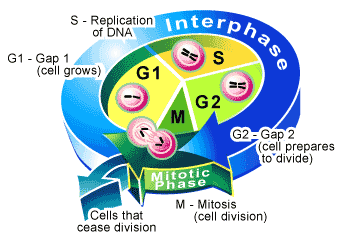Hello my fellow readers!!!!!!!!!!!!
Today I will be teaching you how a cell divides. First, I would like to tell you an amazing fact about cell division, our human body cells divides about a thousands of time in one minute. I found it very amazing and I think you will also find it also amazing.
Now let's get into the cell division process. First I need to tell you that the germ cells and somatic cells are the two classification of the cells in our body and these cells divide in different ways. Germ cells a.k.a. Gamete cells are the cells that are reproduction cells, such as ovum in women and sperm in men. And somatic cells are the cells that do not reproduce.
Their is one common phase in the Cell cycle that both the cell types undergo that is interphase. There are three phases in the interphase. They are:
- G1 Phase.
- S Phase.
- G2 Phase.
During the S phase, the cell starts DNA replication, so that each type of new cell formed gets equal number of genes. Genes are a very important part of our cell, they are like the General Governor of the cell Army, each and every action usually starts from them. So, it is important that the genes must be divided equally so that the cell is able to perform the right way. The genes are the building units of the DNA.
During the G2 Phase, the centrosome replication is complete and the the DNA replication is also complete. At that time, the cell is usually synthesis proteins and other enzymes. But to be remembered that if some cell don't divide and the they are just locked in the G1 phase and are said to be in the G0 phase.
Now let's discuss about the mitosis and meiosis. The somatic cells divide through mitosis process and the germ cell divide through meiosis. First let's talk about mitosis, the mitosis is the process of cell division the includes 4 phases. Prophase, Metaphase, Anaphase, telophase.
In the Prophase, the cell starts dividing itself by first converting the Chromatids into Chromosomes. This is an important part as each cell should have the same amount of Chromosomes to perform the right way. Also in this stage, the cell's nuclear envelope breaks up and nucleoli disappears. The nucleoli is a part that is located within the nucleus of the cell. And the nuclear envelope protects the nucleus. And also in this phase the mitotic spindle starts to form. The mitotic Spindle is an important thing without which the cell could not divide.
To understand the process of mitosis better, here is an image :
In the above image, we can see the full process of mitosis. In the image, the red and green marks indicate the chromosomes. The next phase is the Metaphase, the chromosomes are held together by centrosome, outside of the centrosome have a protein known as Kinetochore, the mitotic spindle attaches to them, and arrange them in a single line known as metaphasic plate. Then in the next phase, the chromosomes are separated into chromatids and they are pushed to the other side of the cells by the mitotic spindle. In this way, both the new cells will be having the same amount of chromatids. The next and the last phase in the process of mitosis is the telophase, in this phase,the nuclear envelope reappears and the parent cell is like pinched out in between to form the two new haploid cell.
The cytokinesis usually starts at the late anaphase and starts to divide the cytoplasmic material. It is usually completed in the telophase but the distribution is usually done roughly.
I will be writing the process of miesosis on later times because I think remembering this much today is still okay for you.
Thanks you for reading!!!!!!!!!!!
 |
| Interphase. |
In the Prophase, the cell starts dividing itself by first converting the Chromatids into Chromosomes. This is an important part as each cell should have the same amount of Chromosomes to perform the right way. Also in this stage, the cell's nuclear envelope breaks up and nucleoli disappears. The nucleoli is a part that is located within the nucleus of the cell. And the nuclear envelope protects the nucleus. And also in this phase the mitotic spindle starts to form. The mitotic Spindle is an important thing without which the cell could not divide.
To understand the process of mitosis better, here is an image :
 |
| Mitosis. |
In the above image, we can see the full process of mitosis. In the image, the red and green marks indicate the chromosomes. The next phase is the Metaphase, the chromosomes are held together by centrosome, outside of the centrosome have a protein known as Kinetochore, the mitotic spindle attaches to them, and arrange them in a single line known as metaphasic plate. Then in the next phase, the chromosomes are separated into chromatids and they are pushed to the other side of the cells by the mitotic spindle. In this way, both the new cells will be having the same amount of chromatids. The next and the last phase in the process of mitosis is the telophase, in this phase,the nuclear envelope reappears and the parent cell is like pinched out in between to form the two new haploid cell.
The cytokinesis usually starts at the late anaphase and starts to divide the cytoplasmic material. It is usually completed in the telophase but the distribution is usually done roughly.
I will be writing the process of miesosis on later times because I think remembering this much today is still okay for you.
Thanks you for reading!!!!!!!!!!!
No comments:
Post a Comment